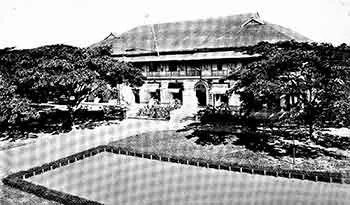Particulars of the First Provincial High School in Batangas Province
As early as the year 1900, a time when, in fact, the Philippine-American War was still raging, the American colonial government had already started to put in place an educational bureaucracy within the country. The mass education of the youth of the Philippines, something that the previous Spanish government did not have an appetite for, was something that the new government intended to pursue as part of its declared policy of “benevolent assimilation.”
In a nutshell, this policy aimed to “win the confidence, respect, and affection of the inhabitants of the Philippines by assuring them in every possible way that full measure of individual rights and liberties which is the heritage of free peoples1” would be the pillars of the new colonial government. Education was a tool which, according to one author, would allow the Americans “to spread their cultural values, particularly the English language, to the Filipino people2.”
Because the new public school system in the Philippines was still in the organizational stage in the early 1900s, Batangas was initially placed in a lone supervisorial division with the provinces of Cavite and Tayabas3. When the war ended in 1902, the people of Batangas were finally allowed by the American military government to return to their homes from their concentration camps and resume their normal civilian lives.
Initially, the Americans perceived “an indifference of the masses to education... failing to perceive that before a people can successfully undertake self-government, the masses of the people must be readers and thinkers4.” Compulsory education was, thus, recommended by the Philippine Commission for municipalities to enforce.
 |
| he Batangas Provincial High School. Image digitally extracted from the July 1914 edition of the Bureau of Public Works Quarterly Bulletin. |
By 1903, in anticipation of more students availing of a free public school education, the Philippine Commission passed an act appropriating funds from the War Emergency Rice Fund for the Province of Batangas for the construction of a provincial school building and manual training schools. The amount appropriated was $50,000.005.
The building would be constructed according to specifications provided by the Insular Bureau of Architecture. A building committee composed of the Provincial Board of Batangas Province; the Batangas Province Superintendent of Schools; the President6 of the Municipality of Batangas, where the school would be built; and three members from Batangas at large were given the task of supervising the construction in cooperation with the Bureau of Public Works.
 |
| The Batangas Provincial High School athletic field. Image digitally extracted from the July 1914 edition of the Bureau of Public Works Quarterly Bulletin. |
Land for the new building was to be donated by the Municipality of Batangas just north of the municipal government’s building. Its first floor would be initally used for the primary schools of the Municipality of Batangas. The second floor, meanwhile, would be utilized as a provincial secondary school. Industrial annex buildings would be used as training schools for young boys and girls7.
As per contract stipulations, construction of the provincial school buildings was expected to have been concluded by the 1st of September 1903. When operational, primary instruction would be given to pupils from the town of Batangas on the first floor, while secondary instruction would be given at the second level to pupils from all over the province.
At the industrial annexes, it was initially foreseen to instruct young boys from different barrios in the crafting of school benches and other furniture which could then be used in the school; as well as in blacksmithing and other crafts. Meanwhile, at the other annex, girls would be instructed more on plain sewing as opposed to embroidery; as well as in cooking, cleanliness and sanitation; and finally on music and drawing. Emphasis on the use of modern tools would be part of the instruction.
The following decade, the provincial high school was complete and considered “a modern building.” In its July 1914 Quarterly Bulletin, the Bureau of Public works reported that the main high school building had “14 classrooms, a large assembly hall, a library, an office and is one of the few buildings in the Islands that is large enough to meet all demands that will likely be made on it for years to come8.”
2 “In Our Image: America’s Empire in the Philippines,” by Stanley Karnow, published 1989 by Random House.
3 “Report of the Commissioner of Education, United States Bureau of Education,” published 1902 in Washington D.C.
4 “Fourth Annual Report of the Philippine Commission,” published 1903 by the Bureau of Insular Affairs, United States War Department, Washington D.C.
5 Along with other particulars about the school building contained in this article, from “Acts of the Philippine Commission (Acts Nos. 425-949),” published 1904 by the Bureau of Insular Affairs, United States War Department, Washington D.C.
6 The President back in 1903 was the equivalent of the present-day Mayor.
7 “Fourth Annual Report of the Philippine Commission,” op. cit.
8 “Bureau of Public Works Quarterly Bulletin,” Volume 3 Number 2, published July 1914 by the Contruction Division, Bureau of Public Works.
